High-end shops in Ginza don’t normally plaster their windows with hastily photocopied announcements, but the photo above shows that a men’s shoe store that ritzy district has become one of countless Japanese businesses to jump on the “setusden” bandwagon.
“Setsuden” means “saving electricity.” The sign in the shoe shop window informs customers that the shop is lit more dimly than usual for the sake of conserving power. With many of Japan’s power plants shut down as a direct or indirect result of this spring’s earthquake and tsunami, “setsuden” has become this summer’s big buzzword. The term is written with the pair of kanji characters at the top of the shoe shop’s sign. Take a moment to look carefully at those characters. If you live in Japan or plan to visit (and please do visit — our economy over here could use the help), you’re going to see these two characters everywhere.
For example, here is a sign at an entrance to the Matsuya department store in Ginza, telling customers that the air conditioning has been turned down to save power. The message is printed on a background shaped like a hand-held paper fan, suggesting an alternative way to keep cool. The fan’s lettering reads, “Kotoshi wa, setsuden o kangaeruu,” which means, “This year, we are thinking about saving electricity.” The last word is written in katakana phonetic characters to emphasize that it is a pun. “Kangaeru” is the correct Japanese word for think, but here it has been slightly altered to make it sound more like “kangaruu,” which is the word for kangaroo. And that’s why there is a kangaroo holding the fan — not just because it is cute.
The power hand driers in many public restrooms have been turned off to save electricity, such as this one I photographed at a shopping mall in the Tokyo suburb of Kawaguchi, Saitama Prefecture. Here, the two characters for “setsuden” are followed by a third character. This simple-looking character is an extremely versatile one with many uses, but here it is pronounced “chuu” and means “in progress,” “under way,” or “in the middle of.” It is often used as a suffix to words that describe activities, so here it means something like “now conserving energy.” Walking around town, you’ll see the three characters for “setsuden-chuu” quite a lot.
For example, here we see “setsuden-chuu” on a closed escalator at Yoga Station on the Denentoshi Line in Setagaya Ward, Tokyo.
And back at the Kawaguchi mall, here are two “setsuden-chuu” signs, explaining why an advertising video screen and a beverage heater/cooler have been turned off.
 Even fish are getting into the act, with these specimens in the lobby of my sports club bragging that the light in their tank is from LEDs.
Even fish are getting into the act, with these specimens in the lobby of my sports club bragging that the light in their tank is from LEDs.
Here’s a Ginza dental clinic whose setsuden sign includes an anthropomorphic tooth mascot climing Tokyo Tower in King Kong style.
The McDonald’s at Korakuen subway station in Tokyo is displaying a setsuden sign that turns a lightbulb filament into its golden arches. I’m not sure this is such a good idea, because at first glance it seems to associate their logo with electricity use rather than savings. The word “setsuden” is not prominently displayed on this poster, but it’s there if you look.
One of McDonald’s restaurants is a tonkatsu pork cutlet restaurant that has a much plainer setsuden sign.
While I was at Korakuen Station, I noticed the word “setsuden” crawling past on an electronic announcement display. This might strike some people as ironic, but if the displays have to be kept on to inform passengers of information such as suicide delays, they may as well also include some positive messages about saving energy.
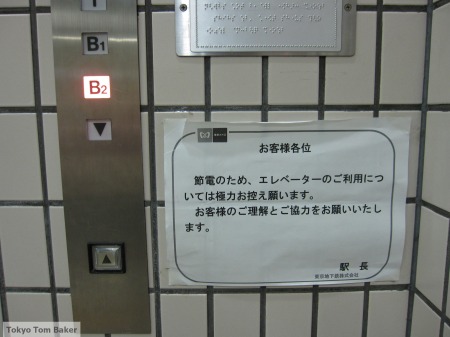 The elevators were also still on at the station — as they must be for the sake of the disabled, the elderly and people with baby carriages — but this sign asks, “stesuden no tame” (for the sake of setsuden), that people refrain from using them as much as possible.
The elevators were also still on at the station — as they must be for the sake of the disabled, the elderly and people with baby carriages — but this sign asks, “stesuden no tame” (for the sake of setsuden), that people refrain from using them as much as possible.
This sign next to an elevator at a public gym and pool in Kawaguchi has a hortatory tone: “Please! Everybody setsuden! Genki people use the stairs!”
 Meanwhile, at a similar facility in Ikebukuro, Tokyo, which has its entrance on the ninth floor, a setsuden sign announces that the middle elevator in a bank of three has been shut down to save energy. The air conditioning in the elevators apparently had also been shut off at the time of my last visit there, and air inside the glass elevator cars was baking.
Meanwhile, at a similar facility in Ikebukuro, Tokyo, which has its entrance on the ninth floor, a setsuden sign announces that the middle elevator in a bank of three has been shut down to save energy. The air conditioning in the elevators apparently had also been shut off at the time of my last visit there, and air inside the glass elevator cars was baking.
A setsuden sign upstairs in the same building asks for everyone’s cooperation.
 A sign in the window of a Domino’s pizza shop in Kawaguchi announces that their setsuden measures include turning off their neon sign.
A sign in the window of a Domino’s pizza shop in Kawaguchi announces that their setsuden measures include turning off their neon sign.
 Daitune, an udon and tempura shop in Ginza where I had lunch yesterday, has a hand-written setsuden sign in its window. There was no air conditioning inside, but the doors were kept wide open.
Daitune, an udon and tempura shop in Ginza where I had lunch yesterday, has a hand-written setsuden sign in its window. There was no air conditioning inside, but the doors were kept wide open.
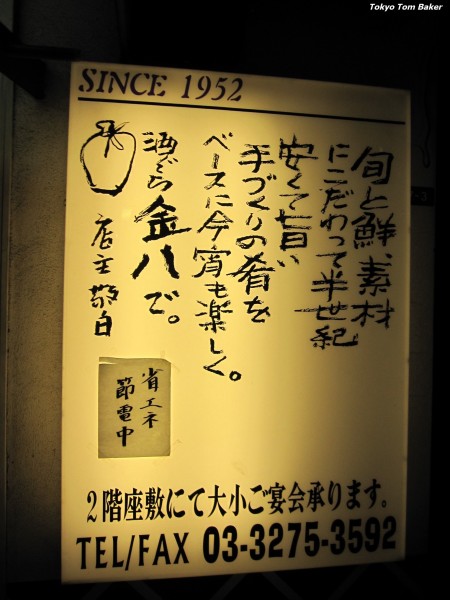 A bar in the Yaesu district adjacent to Tokyo Station had a similar sign, and a similar practice.
A bar in the Yaesu district adjacent to Tokyo Station had a similar sign, and a similar practice.
Here’s a close-up of the Yaesu bar sign. Next to the word “setsuden-chuu,” you can see three characters that are read “shou-ene.” This is short for “shou-enerugii,” which means saving energy. This seems redundant to me, but it is another common feature of many setsuden signs.
Here’s a setsuden sign at a bar in Ginza.
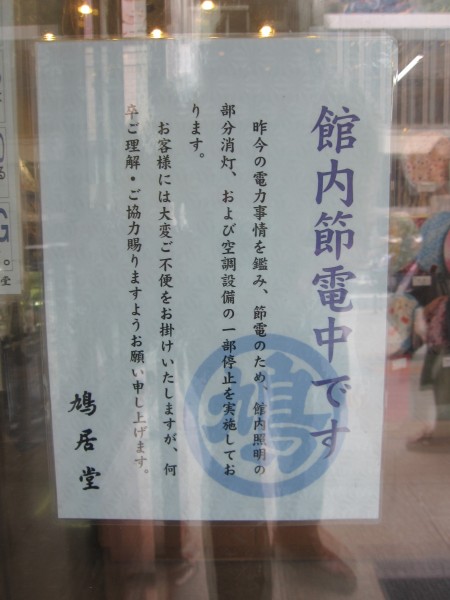 This setsuden sign is in the front window of a Ginza shop called Kyukyodo, a purveyor of traditional Japanese luxury goods that is currently emphasizing its selection of elegant fans and cooling furin wind chimes. They should do a booming business this summer.
This setsuden sign is in the front window of a Ginza shop called Kyukyodo, a purveyor of traditional Japanese luxury goods that is currently emphasizing its selection of elegant fans and cooling furin wind chimes. They should do a booming business this summer.
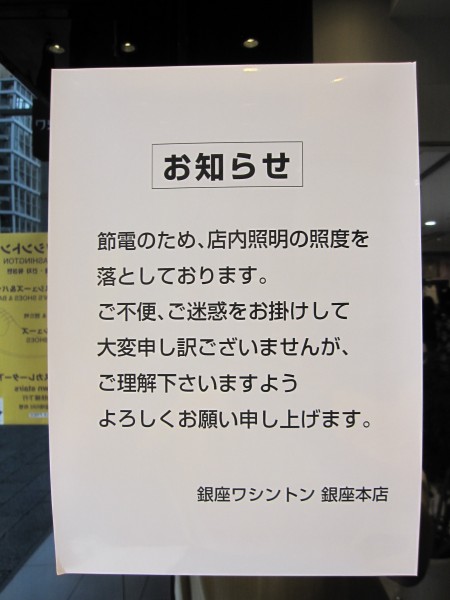 This setsuden sign at the Washington Building, home of Uniqlo’s main Ginza store, says that the lights have been dimmed.
This setsuden sign at the Washington Building, home of Uniqlo’s main Ginza store, says that the lights have been dimmed.
This setsuden sign on an ATM in Korakuen Station says its operating hours have been reduced to 9 a.m. to 6 p.m. to save electricity.
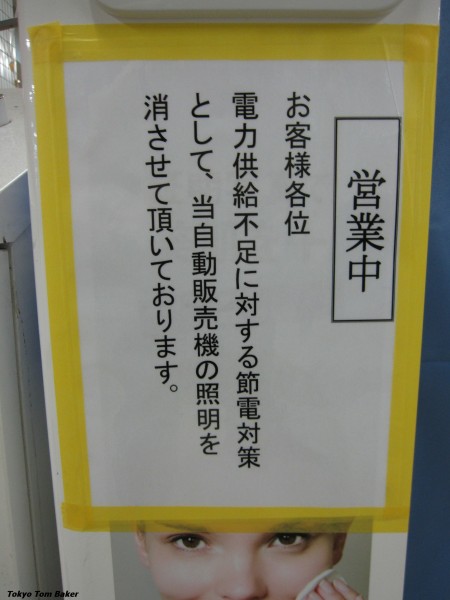 A sign at an ID photo booth in the same station says its lights — presumably not including the flash — have been dimmed for setsuden. Interestingly, the sign describes the machine as a “jidoubaiki,” or vending machine. Before stopping to take this photo, I hadn’t realized that photo booths count as vending machines in Japanese.
A sign at an ID photo booth in the same station says its lights — presumably not including the flash — have been dimmed for setsuden. Interestingly, the sign describes the machine as a “jidoubaiki,” or vending machine. Before stopping to take this photo, I hadn’t realized that photo booths count as vending machines in Japanese.
 Here’s a setsuden sign on a more conventional vending machine, run by Pepsi Japan.
Here’s a setsuden sign on a more conventional vending machine, run by Pepsi Japan.
Here’s a setsuden announcement at another dimly lit vending machine. In addition to reducing or turning off their lights, many vending machine operators have also reduced the daily hours during which their refrigeration units are running.
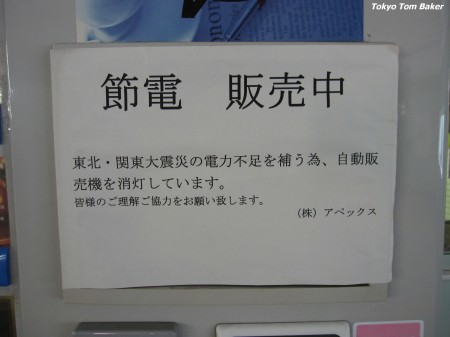 On this drink machine’s sign, the word “setsuden” appears next to a three character word pronounced “hanbai-chuu,” which means “now selling” — or in this case, “now still selling.”
On this drink machine’s sign, the word “setsuden” appears next to a three character word pronounced “hanbai-chuu,” which means “now selling” — or in this case, “now still selling.”
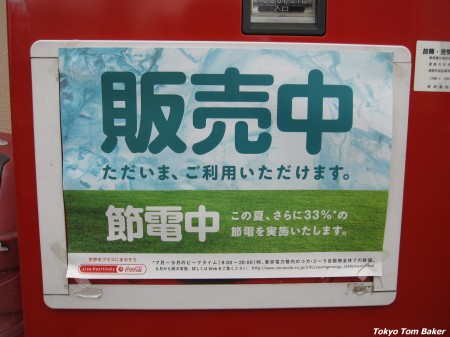 On this drink machine’s sign, “hanbai-chuu” gets pride of place, and “setsuden-chuu” gets second billing.
On this drink machine’s sign, “hanbai-chuu” gets pride of place, and “setsuden-chuu” gets second billing.
 Here they get more equal emphasis.
Here they get more equal emphasis.
 And here’s one more drink vending machine pleading its case. Vending machine companies have been on the defensive since Tokyo Gov. Shintaro Ishihara condemned their business as wasteful, but if you live or work in Japan and don’t belong to a group that Ishihara has criticized, then you probably aren’t doing anything interesting or worthwhile.
And here’s one more drink vending machine pleading its case. Vending machine companies have been on the defensive since Tokyo Gov. Shintaro Ishihara condemned their business as wasteful, but if you live or work in Japan and don’t belong to a group that Ishihara has criticized, then you probably aren’t doing anything interesting or worthwhile.
This has been quite a long blog post, but there are two special setsuden signs that I have left out. The signs to which I refer are my favorites — one for its appealing visual style, and one for its amusing wordplay. The’re so good I’m going to give them each their own blog entry later this week. So stay tuned!
 Update
Update
Here’s my pick for best design on a setsuden sign. Read more about it here.
 And here’s my pick for best wordplay — a setsuden sign that uses bilingual puns. Read more about it here.
And here’s my pick for best wordplay — a setsuden sign that uses bilingual puns. Read more about it here.









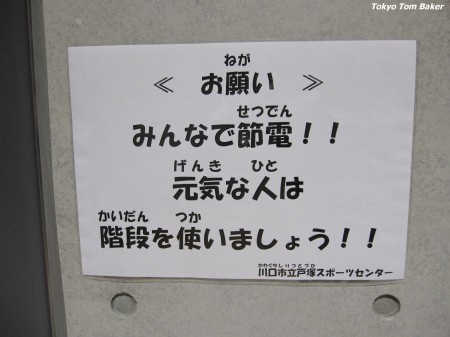
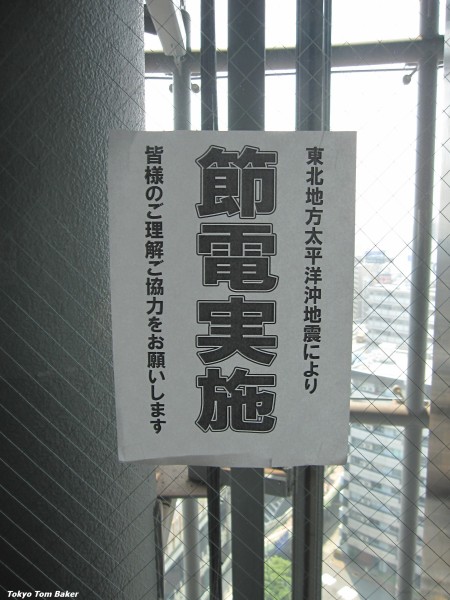
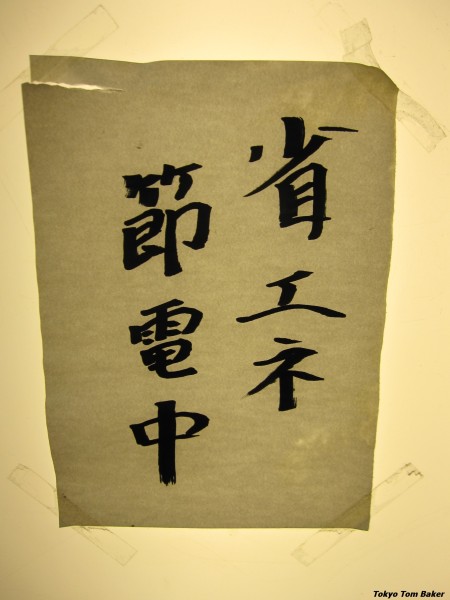



June 15, 2011 at 10:55 am |
Nice post! Actually, the photo booth probably just has a “generic” pamphlet on it. JPN people do not actually clasify them 自動販売機
I think you should also talk about how Pachinko parlors very distinctively do NOT do setsuden… either they should be forced to as well, or those escalators shouldn’t be off.
July 22, 2011 at 3:08 am |
http://setsuden.tumblr.com/ has many of these…
September 10, 2011 at 1:28 pm |
useful information, thanks – only thing I would have liked to see is some explanation of the two characters making up the word itself
January 30, 2012 at 12:14 pm |
photo booth…
[…]Major Japanese buzzword: “Setsuden” « Tokyo Tom Baker: The Blog[…]…
June 16, 2014 at 5:09 pm |
[…] In context: Major Japanese buzzword: “Setsuden” […]